Name Martin Murua | ||
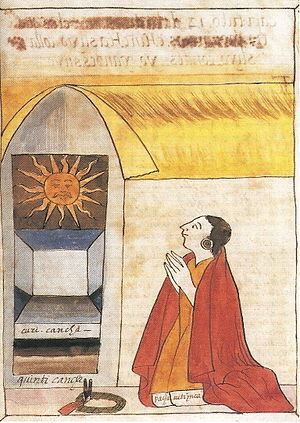 | ||
Guam n poma y mart n de mur a por juan ossio
Martín de Murúa, O. de M., (Gipuzkoa, Spain, c. 1525 – Spain, c. 1618) was a Basque Mercedarian friar and chronicler of the Spanish conquest of the Americas. He is primarily known for his work Historia general del Piru (written c.1580-1616), which is considered the earliest illustrated history of Peru.
Contents
- Guam n poma y mart n de mur a por juan ossio
- Juan ossio influencias rec procas entre guaman poma y mart n de mur a la cultura del libro bnp
- Muras career in Peru
- The Galvin and Getty manuscripts
- Muras Historia general del Piru 1616
- Mura and Guaman Poma
- Citations
- Works
- References
Juan ossio influencias rec procas entre guaman poma y mart n de mur a la cultura del libro bnp
Murúa's career in Peru
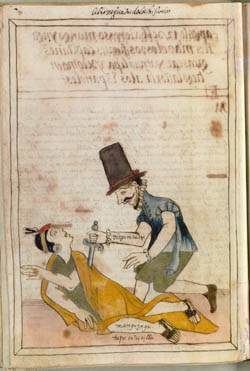
Murúa volunteered to serve in the missions of New Spain, where he was sent by his superiors, arriving in Peru in the early 1580s. He is known to have lived in the Curahuasi Valley around that period. He later traveled throughout the Viceroyalty of Peru as a missionary, serving in the proximities of Lake Titicaca and Cuzco, where he came to know some features of the inhabitants of the former Inca Empire very well. From about 1595 to 1601 his residence was at the Mercedarian Monastery of St. John Lateran in Arequipa.
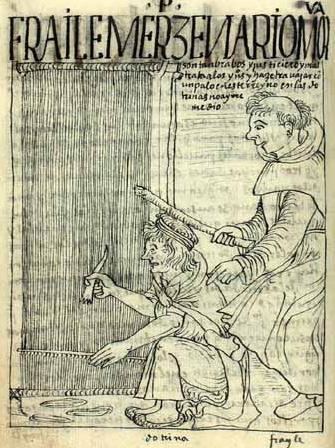
In addition to his missionary work, Murúa was devoted to the task of gathering data to write a history of the Incan past. He was assisted in his translation of the date from the Quechua language by a native Incan nobleman Felipe Guaman Poma de Ayala (also known as Guaman Poma), who provided over 100 illustrations of great historical significance for the work, but who was later highly critical of Murúa's depiction of Inca history in his own writings.
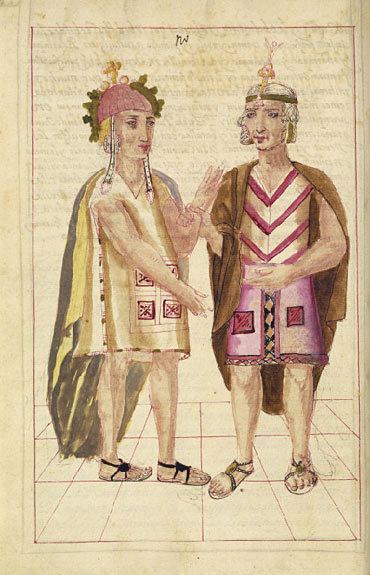
In 1611, Murúa made the decision to return to Spain. He chose, however, not to take the usual route, by way of Panama. Instead, he traveled across the Amazon Forest, crossing the Andes, arriving in La Plata. After a lengthy stay, from there he went on to Potosí and then to the Tucumán region. All along the way, he took the opportunity to have the local religious and government authorities review his work for comment and correction. He eventually passed through Córdoba and arrived in Buenos Aires, from which he set sail for Spain in 1615.
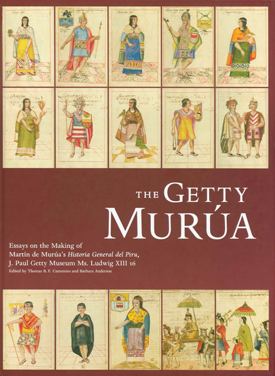
The following year, while living in Madrid, Murúa received the necessary authorizations from both his Order and the king to publish his chronicle, entitled Historia general del Piru. The work covers Peru's pre-Columbian and early Spanish colonial history. In his Historia, Murúa wrote of the presence of a number of mythological creatures in South America, such as Amazons and giants, which gave rise to the names of many geographical landmarks of the continent.
The Galvin and Getty manuscripts
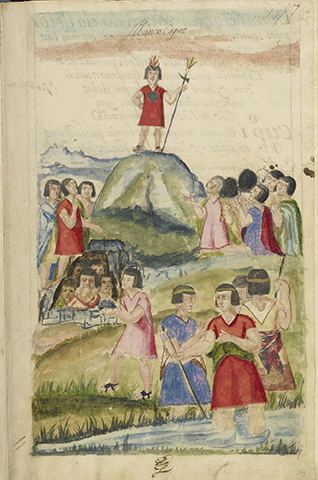
There exist two versions of the Historia general del Piru: the Galvin Murúa (also known as the "Loyola Murúa") and the Getty Murúa (also known as the "Wellington Murúa"). The former is kept in a private collection in Ireland while the latter is at the Getty Research Institute in Los Angeles, California. The original as well as a facsimile of the Galvin Murúa are available at the Getty Center for consultation by qualified scholars.
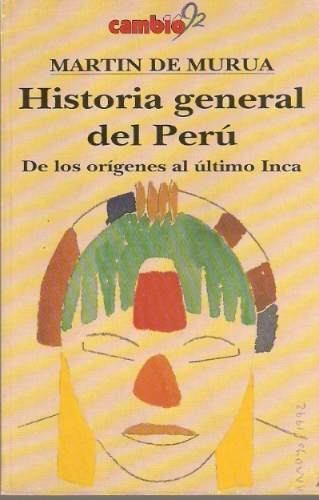
The Galvin Murúa dates from the 1580s and was completed around 1600. This first version of the chronicle was compiled in Peru by Murúa with the assistance of local scribes and Indigenous artists (one of whom was Felipe Guaman Poma de Ayala). By the 18th century, the Galvin Murúa ended up in the possession of the Jesuit College in Alcalá de Henares, Spain. Between 1879-1900, the manuscript was housed in a Jesuit enclave in Poyanne, France. Its association with the Jesuits gave the manuscript its title the "Loyola Murúa" (after St. Ignatius of Loyola, founder of the Jesuit Order). In the 1950s, the manuscript was bought by a rare bookseller in San Francisco, California and resold to the late John Galvin (d. 1996), a European aristocrat and private collector. The text remains in the hands of the Galvin family in County Meath, Ireland.
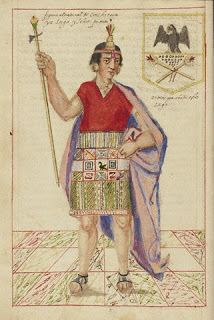
The Getty Murúa dates from 1615–16 and was the second version of the chronicle. Most of the text was compiled in Peru and present-day Bolivia, although it was most likely re-edited in Spain. This version received the final approbation for printing, however for unknown reasons it remained unpublished during the seventeenth century. Once in Spain, the manuscript was somehow acquired by Castilian statesman and bibliophile Lorenzo Ramirez de Prado. After Ramirez's death in 1658, it was incorporated into the library of the Colegio Mayor de Cuenca in Salamanca and finally the private library of King Charles IV of Spain in 1802. As a result of the Peninsular War, it came into the possession of Arthur Wellesley, 1st Duke of Wellington. Thus the manuscript acquired the title the "Wellington Murúa." It was later sold at auction to a collector in Cologne, Germany, changing hands once more before its "rediscovery" by Manuel Ballesteros Gaibrois in the early 1950s. Ballesteros Gaibrois published a two volume edition of Historia general del Piru in 1962 and 1964. In 1983, the manuscript was sold to the Getty Research Institute. Since then it has been known as the "Getty Murúa."
Research has proven that several images (including two by Guaman Poma) from the Galvin Murúa were removed and pasted into the Getty Murúa, although overall the Galvin Murúa contains more images than its counterpart. The images in both manuscripts were colored using paints, dyes, and silver from the Americas and Europe. An exhaustive study of both manuscripts was funded by the Getty Research Institute in 2007-2008.
Murúa's Historia general del Piru (1616)
Murúa's chronicle is divided into three books. The following is the complete title of the work:
The first book is divided into 92 chapters and contains the following:
The second book has 40 chapters and includes the following:
Finally, the third book contains the following in 31 chapters:
Murúa worked closely with indigenous peoples in compiling his text, incorporating their testimonies and oral accounts of Incan culture and political history into Historia general del Piru. The most striking feature of the chronicle is its numerous illustrations, which include portraits of Incan nobility and depictions of traditional ceremonies. These images blend European and indigenous artistic traditions.
Murúa and Guaman Poma
Twentieth-century scholars had often speculated that there existed some relationship between Guaman Poma's Nueva Crónica y Buen Gobierno and Fray Martín de Murúa's Historia general del Piru (1616), assuming that Guaman Poma served as an informant or coauthor to Murúa. In 1967, Condarco Morales performed a comparative study of the texts and concluded that Guaman Poma followed Murúa's work. A direct relationship between Guaman Poma and Murúa was confirmed by the Getty research project (2007–2008). The project's principal scholars included Juan de Ossio, Thomas Cummins, and Barbara Anderson, with collaboration by Rolena Adorno and Ivan Boserup. After comparing the Getty Murúa and Galvin Murúa, these scholars proved that the chronicle does in fact include illustrations by Guaman Poma. They concluded that Guaman Poma was one of a team of scribes and artists that worked for Murúa while he was in Peru. While Murúa's project began sometime in the 1580s, Guaman Poma became involved only as an illustrator and only shortly before 1600. These findings were the basis of an exhibition and symposium at the Getty Center in October 2008.
Guaman Poma notably attacks Murúa in his Corónica, even depicting the friar striking and kicking an indigenous woman seated at a loom. This image is entitled "The Mercedarian friar Martín de Murúa abuses his parishioners and takes justice into his own hands." According to Rolena Adorno, "... when he became an author after 1600, [Guaman Poma] was highly critical of a work by Murúa that he had recently illustrated. Guaman Poma was prompted to write his own account against what he understood to be Murúa's limited perspective, which he had encountered in the Galvin Murúa. Guaman Poma extended Andean history back in time of the era predating the Inca, and he also elaborated a long and highly critical survey of colonial society such as no other chronicle of his time produced. Guaman Poma's artistic repertoire, which was displayed in his own work in the creation of nearly four hundred drawings, drew upon the formative experience he had gained while working with Murúa, but it also developed in new directions to reveal a strong polemical and satirical bent that was directed against the abuses perpetrated under colonial rule ... Although the evidence suggests that they worked independently after 1600, the efforts of Murúa and Guaman Poma can never be separated, and their talents, individually and together, produced three distinctive testimonies to the interaction between missionary author and indigenous artist-cum-author in early colonial Peru." [1]
